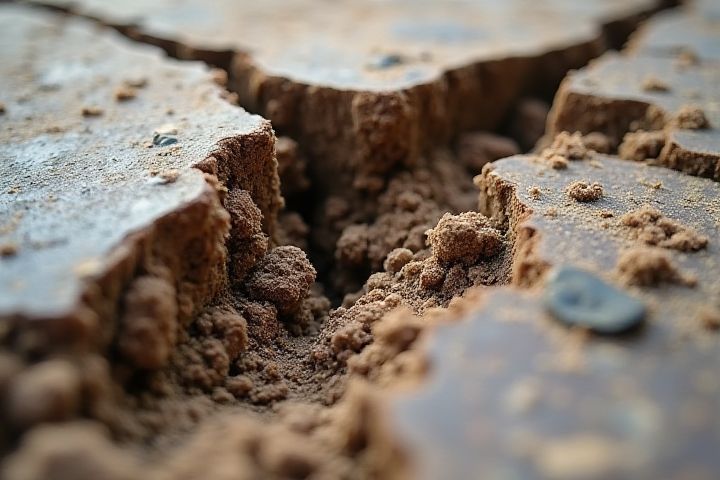
House foundations often crack due to a combination of settling, soil movement, and moisture fluctuations. Poor drainage can lead to excess water accumulation, causing the soil to expand and contract, which puts pressure on the foundation. Additionally, tree roots or nearby construction can disrupt the stability of the ground beneath the foundation. Temperature changes also play a role, where freezing and thawing cycles can exacerbate existing cracks. Regular monitoring and maintenance can help prevent further damage and ensure the structural integrity of your home.
Why Do House Foundations Crack
Soil movement
House foundations often crack due to soil movement, which can occur from various factors, such as moisture fluctuations or soil expansion and contraction. For instance, clay soils can swell significantly when wet, increasing pressure on the foundation, while they shrink in dry conditions, leading to gaps and cracks. According to the American Society of Civil Engineers, approximately 25% of all residential foundation failures are attributed to improper drainage and shifting soil. It's crucial to monitor your home's drainage system and maintain consistent moisture levels in the soil to prevent potential foundation damage.
Poor drainage
Poor drainage is a leading cause of house foundation cracks, as excess water accumulates around the foundation, increasing hydrostatic pressure. Clay-rich soils, which expand when wet and shrink when dry, exacerbate this issue and can lead to significant foundation movement. Over time, the stress from the shifting soil may result in visible cracks, particularly on exterior walls and basement floors. To protect your investment, ensure proper grading and install adequate drainage systems, such as French drains or gutters, to direct water away from the foundation.
Tree root growth
Tree root growth can exert significant pressure on house foundations, leading to cracks over time. The expansive roots can infiltrate the soil beneath a foundation, causing uneven settling or heaving, especially in areas with clay soils that expand when wet. In fact, studies show that disturbances in soil moisture levels, often due to nearby tree root systems, can result in foundation shifts of up to 3 inches. To mitigate this risk, consider maintaining a distance of at least 10 feet between trees and your home to help protect your foundation from potential damage.
Seasonal changes
Seasonal changes significantly influence the structural integrity of house foundations, primarily due to the expansion and contraction of soil. During periods of heavy rainfall, soil moisture levels rise, causing the soil to swell, which exerts pressure on foundation walls. Conversely, in dry seasons, the soil can shrink, leading to gaps and creating tension that often results in cracks. You need to monitor these seasonal fluctuations and consider implementing proper drainage systems to help protect your foundation from damage.
Inadequate construction
Inadequate construction practices can lead to significant issues in house foundations, resulting in cracks that compromise structural integrity. Poorly mixed concrete, which should ideally use a water-cement ratio of about 0.5, may not provide the necessary strength, leading to premature deterioration. Insufficient reinforcement, such as failing to install adequate steel rebar according to local building codes, can cause foundations to shift under stress, exacerbating crack formation. Ensuring quality workmanship and adherence to industry standards is crucial, as studies show that about 80% of foundation problems stem from these initial construction deficiencies.
Settlement
Foundation cracking often stems from settlement, which occurs when soil beneath the structure shifts or compresses. Approximately 25% of homes experience some form of foundation movement due to soil type, moisture levels, or added load from nearby structures or landscaping. Poor drainage can exacerbate these issues, leading to uneven soil moisture that promotes differential settlement. Monitoring your foundation for cracks larger than 1/4 inch can help identify significant problems early, potentially saving you thousands in repair costs.
Water leaks
Water leaks are a significant contributor to house foundation cracks, primarily causing soil erosion and instability. When water seeps into the ground around the foundation, it can saturate the soil, leading to increased pressure on the foundation walls. Over time, this excessive pressure can result in cracks typically ranging from 1/8 inch to 1/4 inch wide. Monitoring your property for signs of water leaks and addressing drainage issues promptly can help prevent foundation damage and costly repairs.
Earthquakes
Earthquakes can significantly impact house foundations, leading to cracks that compromise structural integrity. During seismic activity, the ground shakes violently, exerting lateral forces on the foundation, which can cause shifting or settling. Statistics indicate that nearly 60% of homes in earthquake-prone areas experience some degree of foundation damage following significant quakes. To protect your home, retrofitting techniques and proper drainage systems can help mitigate the risk of foundation cracks.
Temperature fluctuations
Temperature fluctuations can lead to significant stress on house foundations, causing cracks to develop over time. As temperatures rise, materials such as concrete expand, while cooler temperatures cause them to contract, creating tension within the structure. When these shifts occur rapidly or frequently, the foundation can experience structural fatigue, leading to visible cracks. Ensuring proper insulation and drainage around your home can mitigate the impact of temperature changes on your foundation's integrity.
Heavy loads
Heavy loads are a primary contributing factor to foundation cracks, as they can exert excessive pressure on the soil beneath a structure. When the weight of the building coupled with additional loads, such as vehicles or landscaping features, exceeds the soil's bearing capacity, the foundation may shift or settle unevenly. This uneven settlement can result in stress fractures--often visible as vertical or horizontal cracks in the walls or floors of your home. Monitoring and addressing any signs of foundation crumbles, such as gaps or leaning walls, can help maintain the integrity of your property and prevent costly repairs.
